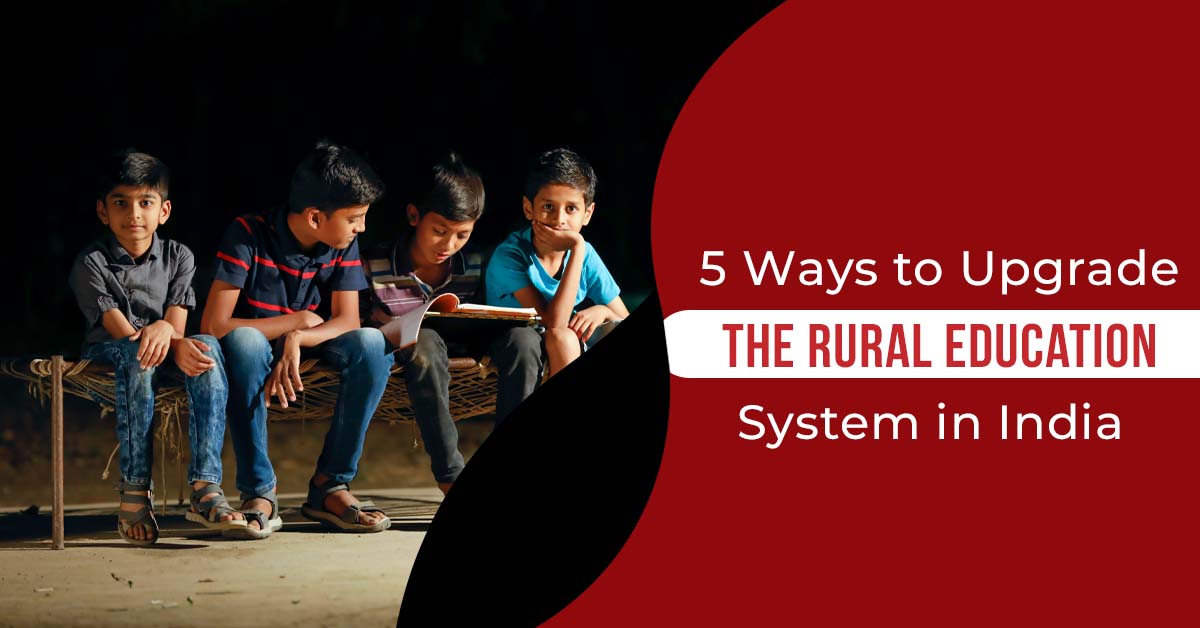
September 13, 2022
5 Ways to Upgrade The Rural Education System in India
Rural education may be at a disadvantage due to its location and lack of resources, but by taking steps to address the problem, a significant portion of illiteracy will be eliminated.
The criticisms about the lack of organisation, systematisation, and proper structure of the rural education system have been around for a while. However, a few organisations have stepped up to support India's rural education because it is one of the metrics for measuring the country's growth.
The potential for universal primary education in rural India is considerable. It requires a methodical approach supported by cooperative efforts from governmental and non-governmental organisations (NGOs).
To address school dropouts, insufficient classroom size, a teacher shortage, and the absence of fundamental daily education, the shared vision must include targeted interventions. It is crucial to have relationships between the government and nongovernmental organisations (NGOs) to support young children and non-school-age children who are part of immigrant communities, attend underdeveloped schools, or belong to programmed tribes.
Ways to Upgrade The Rural Education System:
Boost free education:
In rural India, poverty is a very serious and pervasive issue. Driving instruction in rural locations is also hampered by this. If adequate free education is offered in these places, this serious issue can be readily handled. The Indian government should assist youngsters from very low-income families with their education by giving books, lab space, and library resources. In rural places, expanding free education can aid in reducing poverty.
Providing nutrition:
Kids miss school because they have jobs to go to. In any case, they must eat. Millions of kids around the world continue to skip school due to hunger.
Many kids in the poorest areas have to trek hours to school on an empty stomach because their parents frequently have to leave for work extremely early in the morning. Parents are also concerned for their kids' safety if they try to cook by themselves. Instead of sending their children to school, many families choose to bring them to the fields with them so they can be fed.
In response, the government started the National School Meals Programme, which gave kids in the neediest provinces free lunches at school. Local volunteers are in charge of this effort, which is supported by the neighbourhood, and they use locally farmed food to make wholesome meals. Fresh fruits and vegetables are often delivered to the classrooms by neighbourhood farmers.
Result-oriented learning environment:
There may be other outcomes that are important, such as extracurricular activities, personality development, and behaviour development, and rural schools should have the tools to create a learning environment that will enable teachers to achieve results in all of the areas mentioned above. Education in rural areas focuses mainly on academic achievement.
It is important to focus on academic results, but other outcomes may be important. Teachers need assistance and resources to create an environment that is both healthy and enjoyable.
Improve the number of well-trained teachers:
When the infrastructure problem is resolved, a different common issue typically surfaces. The shortage of teachers in rural schools is the issue. These schools have one or two teachers who educate the child. So, the level of education is directly impacted by this issue. A large number of highly qualified teachers should be employed in rural schools to enhance the teaching methodology. Smart teaching methods are something that good teachers always give their students.
Work on school infrastructure:
Rural educational institutions experience severe losses as a result of inadequate infrastructure. The number of qualified teachers in rural Indian schools is insufficient. This results in education that is of poor quality and serves little purpose.
There are an increasing number of parents in India who recognise the value of education for children who live in rural areas. However, there are not many schools in India that are challenging to comprehend.
Only if the government attempts to provide inexpensive and cost-effective schools for both middle and lower economic groups will the remedy be sought.
The building of a solid educational life must begin at the outset, and this is only possible if the infrastructure of the school is done effectively.
Volunteer programs:
Volunteer programmes can address the fundamental issue of promoting education in rural communities. If a small group or organisation can travel to rural locations and set up a camp-like setting for research. It encourages more kids to attend school and will alter how their parents are seen by the next generation.
Promoting Computer Education:
In our area, technology is advancing, but sadly, rural areas have not yet reached this stage of development. For computer education in rural India, schools are essential, and technical knowledge must be taught. Thus, computer instruction must be provided in rural Indian schools.
Involvement of Parents:
In contrast to the rural education system, where parents are involved either at the time of admissions or at the time of final results, there is a lot of focus and several forums developed by schools to involve parents in the educational process in metropolitan regions.
The possibility of a parent being uninterested is less likely because it concerns their child's future, regardless of whether they do not want to get involved or are uninterested. An initiative to educate parents, highlighting their role and the forums available for them to participate in, will be really helpful and it will increase the involvement of parents and it will be a critical input in improving the educational system. Parents are not aware of and therefore only partially involved in the overall process of educating their child.